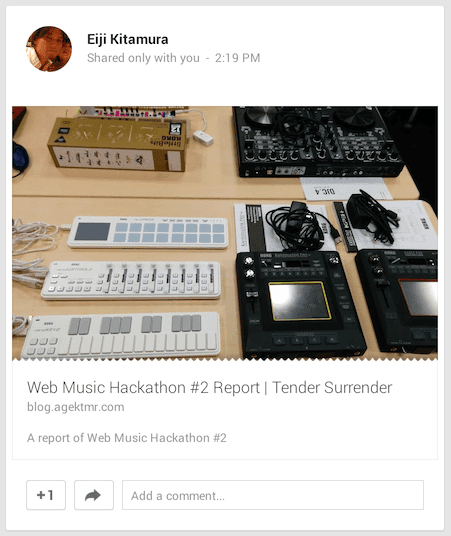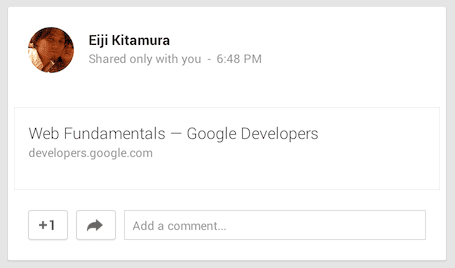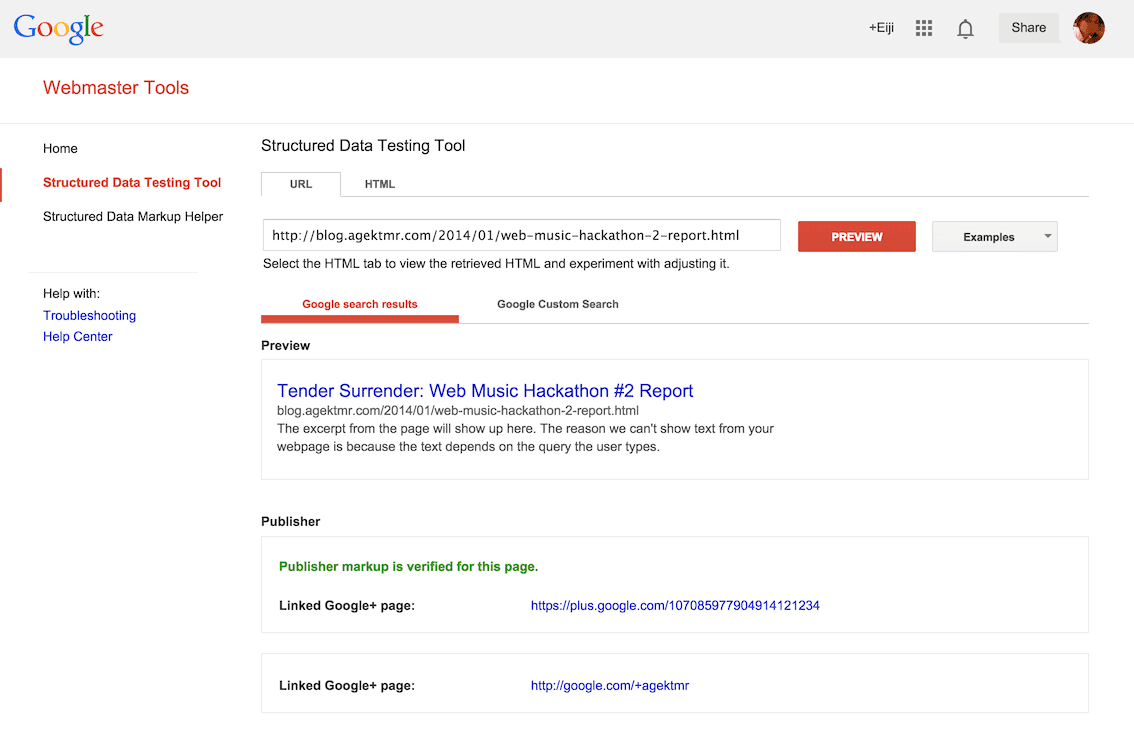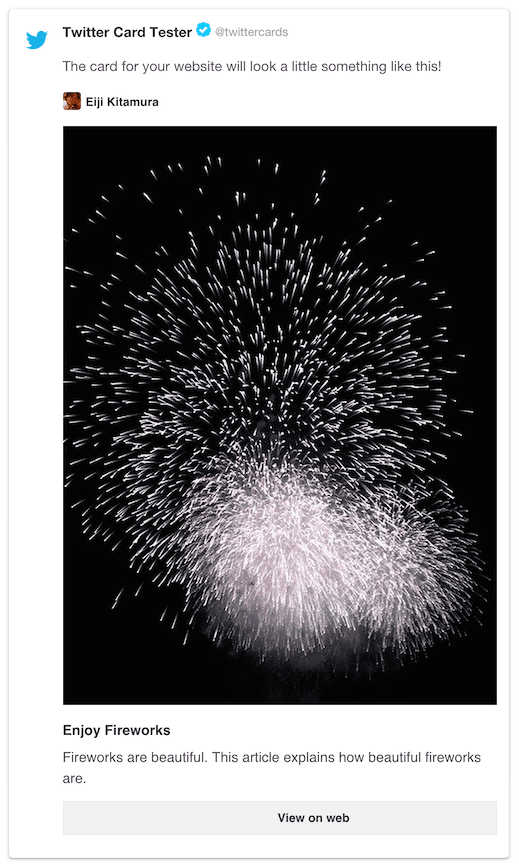You can influence the way your site appears when shared via social media by adding a few lines of code to each page. This can help bring more people to your site by providing previews with richer information than would otherwise be available.
You can influence the way your site appears when shared via social media by adding a few lines of code to each page. This can help bring more people to your site by providing previews with richer information than would otherwise be available.
Summary
- Use schema.org microdata to provide page title, description, and an image for Google+.
- Use Open Graph Protocol (OGP) to provide page title, description, and an image for Facebook.
- Use Twitter Cards to provide page title, description, an image, and a Twitter id for Twitter.
You can influence the way your site appears when shared via social media by adding a few lines of code to each page. This can help increase engagement by providing previews with richer information than would otherwise be available. Without it, social sites will provide only basic information, without images or other helpful information.
Which one do you think is more likely to be clicked? People are drawn to images and feel more confident they'll like what they find when they have an early preview.


When someone on a social network wants to share your website with their friends, they would probably add some notes explaining how awesome it is, and share it. But describing a website tends be cumbersome and can miss the point from the page owner's point of view. Some services restrict the number of characters users can put in the note.
By adding the appropriate metadata to your pages, you can simplify the sharing process for users by providing the title, a description, and an attractive image. This means they don't have to spend valuable time (or characters) describing the link.
Use schema.org + microdata to provide rich snippets on Google+
Crawlers use many methods to parse a page and understand its content. By using microdata, and schema.org vocabulary, you help social sites and search engines better understand the contents of the page.
Here's an example:
<div itemscope itemtype="http://schema.org/Article">
<h1 itemprop="name">Enjoy fireworks</h1>
<p itemprop="description">Fireworks are beautiful.
This article explains how beautiful fireworks are.</p>
<img itemprop="image" src="//developers.google.com/web/imgs/fireworks.jpg" />
</div>
While most metadata are embedded in the head section of a web page, microdata lives where the context exists.
Add itemscope to define microdata scope
By adding itemscope, you can specify the tag as a block of contents about a
particular item.
Add itemtype to define type of your website
You can specify the type of item by using the itemtype attribute along with the
itemscope. The value of an itemtype can be determined according to the type
of content on your web page. You should be able to find one that is relevant
in this page.
Add itemprop to describe each item using schema.org vocabulary
itemprop defines properties for itemtype in the scope. For providing
metadata to social sites, typical itemprop values are name, description,
and image.
Validate rich snippets
To validate rich snippets on Google+, you can use tools such as:
- Structured Data Testing Tool - Search Console

Use Open Graph Protocol (OGP) to provide rich snippets on Facebook
The Open Graph Protocol (OGP) provides Facebook with the metadata necessary to allow web pages to have the same functionality as other Facebook objects.
<html prefix="og: http://ogp.me/ns#">
<head>
<meta charset="utf-8">
<meta http-equiv="X-UA-Compatible" content="IE=edge">
<meta name="viewport" content="width=device-width, initial-scale=1">
<link rel="stylesheet" href="https://fonts.googleapis.com/icon?family=Material+Icons">
<link rel="stylesheet" href="https://code.getmdl.io/1.2.1/material.indigo-pink.min.css">
<script defer src="https://code.getmdl.io/1.2.1/material.min.js"></script>
<style>
body {
margin: 2em;
}
</style>
<meta property="og:title" content="Enjoy Fireworks">
<meta property="og:description"
content="Fireworks are beautiful. This article explains how beautiful fireworks are.">
<meta property="og:image"
content="https://developers.google.com/web/imgs/fireworks.jpg">
<meta property="og:url"
content="https://example.com/discovery-and-distribution/optimizations-for-crawlers/social-sites.html">
<meta property="og:type" content="website">
When included in the head section of your page, this metadata provides rich snippet information when the page is shared.
Use og: namespaced meta tags to describe metadata
A meta tag consists of a property attribute and a content attribute.
Properties and contents may take the following values:
| Property | Content |
|---|---|
og:title |
The title of the web page. |
og:description |
The description of the web page. |
og:url |
The canonical url of the web page. |
og:image |
URL to an image attached to the shared post. |
og:type |
A string that indicates the type of the web page. You can find one that is suitable for your web page here. |
These meta tags provide semantic information to crawlers from social sites, like Facebook.
Learn more
To learn more about things you can attach to the post on Facebook, visit the official Open Graph Protocol site.
Validate rich snippets
To validate your markup on Facebook, you can use tools such as:
Use Twitter Cards to provide rich snippets on Twitter
Twitter Cards are an extension to the Open Graph Protocol applicable for Twitter. They allow you to add media attachments like images and video to Tweets with a link to your web page. By adding the appropriate metadata, Tweets with links to your page will have a card added that includes the rich detail you've added.
Use twitter: namespaced meta tags to describe metadata
To get a Twitter Card working, your domain must be
approved and must
contain a meta tag that has twitter:card as the name attribute instead of
property attribute.
Here's a quick example:
<html prefix="og: http://ogp.me/ns#">
<head>
<meta charset="utf-8">
<meta http-equiv="X-UA-Compatible" content="IE=edge">
<meta name="viewport" content="width=device-width, initial-scale=1">
<link rel="stylesheet" href="https://fonts.googleapis.com/icon?family=Material+Icons">
<link rel="stylesheet" href="https://code.getmdl.io/1.2.1/material.indigo-pink.min.css">
<script defer src="https://code.getmdl.io/1.2.1/material.min.js"></script>
<style>
body {
margin: 2em;
}
</style>
<meta property="og:title" content="Enjoy Fireworks">
<meta property="og:description"
content="Fireworks are beautiful. This article explains how beautiful fireworks are.">
<meta property="og:image"
content="https://developers.google.com/web/imgs/fireworks.jpg">
<meta property="og:url"
content="https://example.com/discovery-and-distribution/optimizations-for-crawlers/social-sites.html">
<meta property="og:type" content="website">
<meta name="twitter:card" content="summary_large_image">
<meta name="twitter:site" content="agektmr">
By assigning the Twitter id to the value of twitter:site, Twitter embeds this information in the shared post so that people can easily engage with the page owner.

Learn more
To learn more about Twitter Cards, visit:
Validate rich snippets
To validate your markup, Twitter provides:
The Best Practice
Given all three options, the best thing you can do is to include them all in your web page. Here's an example:
<!-- namespace declaration -->
<html prefix="og: http://ogp.me/ns#">
<!-- define microdata scope and type -->
<head itemscope itemtype="http://schema.org/Article">
<title>Social Site Example</title>
<!-- define ogp and itemprop of microdata in one line -->
<meta property="og:title" itemprop="name" content="Enjoy Fireworks">
<!-- define ogp image -->
<meta property="og:image"
content="https://developers.google.com/web/imgs/fireworks.jpg">
<!-- use link[href] to define image url for microdata -->
<link itemprop="image" href="//developers.google.com/web/imgs/fireworks.jpg">
<!-- define ogp and itemprop of microdata in one line -->
<meta property="og:url"
content="https://example.com/discovery-and-distribution/optimizations-for-crawlers/social-sites2.html">
<!-- define ogp type -->
<meta property="og:type" content="website">
<!-- define twitter cards type -->
<meta name="twitter:card" content="summary_large_image">
<!-- define site's owner twitter id -->
<meta name="twitter:site" content="agektmr">
<!-- define description for ogp and itemprop of microdata in one line -->
<meta property="og:description" itemprop="description"
content="Fireworks are beautiful. This article explains how beautiful fireworks are.">
<!-- general description (separate with ogp and microdata) -->
<meta name="description"
content="Fireworks are beautiful. This article explains how beautiful fireworks are.">
<meta charset="utf-8">
<meta http-equiv="X-UA-Compatible" content="IE=edge">
<meta name="viewport" content="width=device-width, initial-scale=1">
<link rel="stylesheet" href="https://fonts.googleapis.com/icon?family=Material+Icons">
<link rel="stylesheet" href="https://code.getmdl.io/1.2.1/material.indigo-pink.min.css">
<script defer src="https://code.getmdl.io/1.2.1/material.min.js"></script>
<style>
body {
margin: 2em;
}
</style>
</head>
Notice that microdata and OGP share some markup:
itemscopeis located atheadtagtitleanddescriptionare shared between microdata and OGPitemprop="image"is usinglinktag withhrefattribute instead of reusingmetatag withproperty="og:image"
Lastly, make sure to validate that your web page appears as expected on each social site before publishing.

